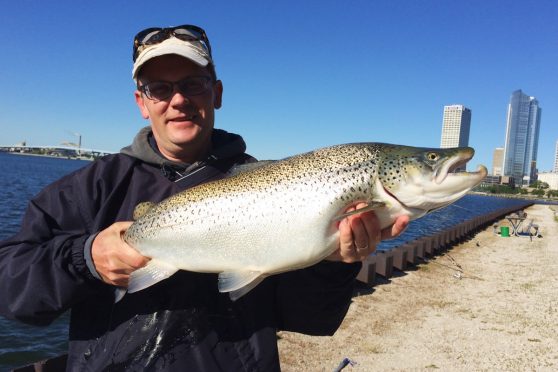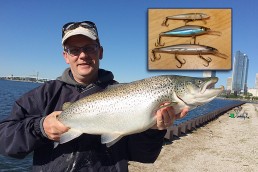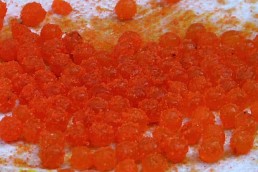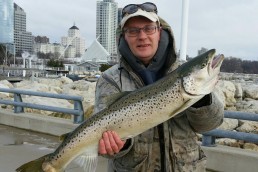Slashing Trout and Salmon: Rip and slash baits are a new twist to minnow baits
SHARE THIS POST
It was June 1974 when I cast my number 9 Blue Floating Rapala from Milwaukee’s Texas Avenue jetties and caught my first Lake Michigan brown trout. It was then that I realized the world of Lake Michigan shore casting didn’t just involve metal spoons.
I beat the heck out of that first Rapala—I had to glue the lip back on, drill a hole and add split shot to try to make it run deeper and cast farther.
Then, later that decade and into the early 80s I discovered the Storm ThunderStick. It was made of plastic and could cast farther. For durability, it could hold up a little longer. ThunderSticks and later Deep ThunderSticks became the go-to lure for spring, fall and shallow-water summer applications.

The slim minnow bait has a natural attraction to almost any freshwater species, and the Lake Michigan trout and salmon are no exception. Whether casting or trolling them, they produce all year long.
The early balsa minnow baits had a subtle swimming action, with more of a horizontal shimmy. The next generation of minnow baits, plastics, had a more pronounced swimming action. But the plastic minnow bait has evolved into much more than that. The latest category of high-tech minnow baits are meant to get “crazy,” and the newest hot bait for Lake Michigan trout, salmon, smallmouth, pike and walleyes are minnow baits called “rip” or “slash” baits.
Rip baits, or slash baits, are a whole new action category of what on the surface looks like standard minnow baits. But they are meant to get wild and crazy. If you just want to, reel in a minnow bait and then stick with the simple ThunderStick or Husky Jerk baits. But you can do stuff with rip and slash baits that would cause their more subtle cousins to blow out of the water.
Before I get into some examples of the new slash bait family, I want to mention that most come in a shallow or deep model. Unless you know for sure that you’ll be fishing them very shallow, go with the deep model for our Lake Michigan shore and pier fishing. The shallow models will run less than 3 feet deep. The “deep” models don’t really run all that deep but you can get them down 6-8 feet, which is usually pretty good for working waters 10-15 feet deep. Don’t worry about being on the bottom with this bait because the violent flash and action will draw fish up from the depths in clear or moderately clear water.
Are you enjoying this post?
You can be among the first to get the latest info on where to go, what to use and how to use it!
Slash baits are also extremely castable. Due to the nature of the presentation used, these baits are made to cast longer distances. Most have weight transfer systems built into them and they fly like an arrow shot out of a bow. Even into the wind, these fly through the air. As shore and pier guys, we like nothing better than to have a bait that will defy the wind and cover a lot of water.
But just like the name says, you can also rip and slash them.
These slash baits are specially designed to be violently pulled through the water and actually veer side to side as much as 3 feet. You can see many bass fishermen snapping their rod tips in a downward fashion. That can be done at times from a seawall, but I’ve found out that a low, sideways rip as if you’re setting a hook is a better position for the pier angler. The pulls should be sharp, swift and constant with an occasional pause. Most of the time the vicious rips and the flash of the lure will get a fish’s attention, but the pause is when the strike will come. Knowing that the strike often comes on the pause makes it important to take up slack quickly and stay in contact with the lure and be in position to set the hook.

The action of these lures is even more amplified when you can snap them on a semi-slack line. Get the rod tip a little ahead of the line and get a little speed going before you get to the taut line. This slack-line rip really sends these baits into action.
There are many good slash baits on the market, so I wouldn’t know where to start. Some are a little pricey and others are fairly reasonable. The River2Sea Suspend 88 and Owner Cultiva Rip N’ Minnow are two that are a little hard to find, but they’re worth the search. The Jackall Squirrel and Lucky Craft Pointer have really proven themselves in the bass world too and for our trout applications. Some other readily available rip baits are the Strike King KVD Deep, The Rapala Deep Shadow Shad Rap, the Shadow Rap and Berkley’s new Cutter or Skinny Cutter. Most of these baits feature a slim coffin-shaped lip that’s designed to work under violent retrieves and not blow out of the water.
And for you small-boat trollers, let these baits out 100-150 feet behind your craft and work them with a pumping action. Don’t just set this one in the rod holder; get active with it.
Rip and slash baits impart a deadly minnow bait action that just says “injured baitfish” all over it. There are times when you just have to make the fish take notice, and this bait will do it. Give one of the new slash baits a try and hang on to your rod tight.
MWO
SHARE THIS POST
Did you enjoy this post?
You can be among the first to get the latest info on where to go, what to use and how to use it!
Marc Wisniewski
Marc Wisniewski is an avid Wisconsin angler specializing in Lake Michigan shore and inshore fishing. He also chases bass, pike, and muskies anywhere he can. He has built custom rods for 35 years and makes lures from wood, lead and soft plastics. Wisniewski has been writing fishing articles for more than 30 years.



